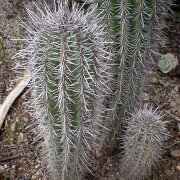Care of the cactus Pachycereus pringlei or Mexican giant cactus |
|
The genus Pachycereus, family Cactaceae, comprises 10 species of cacti native to Mexico and the southwestern United States. Some species are: Pachycereus pringlei, Pachycereus marginatus, Pachycereus pecten-aboriginum, Pachycereus weberi, Pachycereus schottii. Common names: Mexican giant cactus, Elephant cactus. Scientific synonyms: Cereus pringlei, Pilocereus pringlei. This species is native to Baja California and Sonora, Mexico. They are large branched bluish-green cacti that reach 12 meters (39.37 feet) in height and 1 meter (3.28 feet) in diameter. They have 10-16 prominent rounded ribs with large woolly areolas with 20 3 cm (1.18") thick reddish spines and 1-3 longer central spines. The flowers are bell-shaped, appear in adult specimens and are white on the inside and reddish on the outside. They bloom in summer. Mexican giant cactus is used in pots when they are young, in rockery, in cactus and succulent gardens, to form barriers and as isolated specimens. Pachycereus pringlei grows in light shade exposure when young but prefers full sun when adult. The winter temperature should not be less than 3 ºC (37.4 ºF). Young cacti need a soil based on decomposed leaf mulch and coarse sand in the same proportions but when they are adults it's convenient to add some clay to retain moisture. Water moderately at the rate of once a week in summer, in spring every 12-14 days, in autumn every 20-22 days and do not water in winter. Fertilize every 30 days in spring and summer with mineral fertilizer for cacti. Fertilize with compost in early spring when they are adults. Elephant cactus does not need pruning. Pachycereus pringlei is a plant resistant to pests and diseases but sensitive to excess watering. Mexican giant cactus is propagated from seeds sown in spring; Propagation by cuttings is a slow and complicated process. |
Images of the cactus Pachycereus pringlei or Mexican giant cactus |
Find plants
Pachycereus pringlei or Mexican giant cactus | Care and Growing
© 2026 FavThemes



